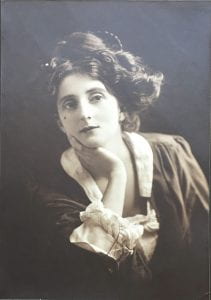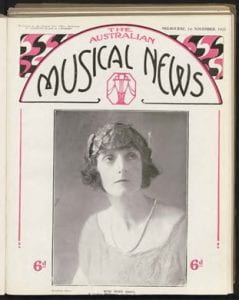Women of the Conservatorium: Ruby Gray
The above photograph, found in the University of Melbourne’s Rare Music Collection, portrays Ruby Gray in full stage costume and make-up for an unknown role. Gray was a very early alumna of the University (Marshall-Hall) Conservatorium, graduating as a “Musical associate”: a fine soprano, as well as an accomplished pianist and accompanist. Gray was one of fourteen children of Irish emigrees Dr Andrew Sexton Gray, pioneering ocular and aural surgeon and founder of the Victorian Eye and Ear Hospital, and Bessie Gray (nee McNalty), ‘one of the belles of early Melbourne’.[1]
Ruby Gray commenced her studies at the Conservatorium in pianoforte and in 1897 was awarded an Exhibition for Performance, a recognition of her considerable talent.[2] At the time the incumbent of the Chair of Music was George William Louis Marshall-Hall. He was a brilliant, and highly controversial character—a bohemian who outraged ‘strait-laced Melburnians’ with his ‘wild’ public behaviour, ardent denouncement of pedantry and advocacy for the ‘power of emotive discipline’.[3] As Ormond Professor of Music, he devised a syllabus that moved away from the established emphasis on ‘pure technique’ and a strict examination system: in fact, on multiple occasions Marshall-Hall attempted to have these examination systems abolished. Instead, the focus of the Marshall-Hall syllabus was to bring out the ‘interpretive sensibility’ and ‘emotional responsiveness’ of each student-musician, working from a solid foundation of technical skill.[4]
In 1898, following the publication of Marshall-Hall’s blasphemously-titled book of poetry, Hymns Ancient and Modern, the Argus newspaper launched a savage attack on both the text and Marshall-Hall’s character, directly disputing his suitability to the role of ‘lecturer to the Young, especially the Young Women, of Victoria’.[5] Ruby Gray joined many of her fellow students in a letter of public protest against the ‘hostile’ treatment of their great and unorthodox professor.[6]
The Argus, (1898-08-12), ‘Professor Marshall-Hall – His Publications’.
From 1899, Gray began accompanying University Conservatorium concerts on the pianoforte as well as singing in performances of opera.[7] Additionally, from 1901, Gray gave a series of solo vocal and pianoforte performances at the Gray family home in Collins Street.[8] By 1902 Gray, by now associated with the Melbourne or Marshall-Hall (and no longer the University) Conservatorium after Marshall-Hall’s University employment ceased, was again acknowledged for her outstanding work as accompanist in acclaimed student performances, conducted by Marshall-Hall himself and often held in the Town Hall.[9] According to one critic, ‘Ruby Gray “accompanied” the voices, which is the highest praise that can be given to accompanists, whose tendency is to give brilliant solo performances and let the voice wander on as it pleases’.[10]
In tandem with her pianoforte career, Gray continued to develop her skills as a soprano. In December 1903 she starred opposite Lovie Mueller in Vaccai’s ‘Romeo et Guillietta’, a standout for many reviewers of the Marshall-Hall Conservatorium Annual Concert that year.[11] The performances of both Mueller and Gray in Romeo et Guillietta were ‘beyond praise’ and the pair received a ‘perfect ovation at the close’.[12] One critic observed that Gray’s Juliet’s ‘Italian style of beauty and slim youthfullness of figure suited her well for this part’ and praised her ‘light and penetrating soprano’ voice, which ‘gave full effect to the music’.[13]
Punch, (1903-12-17), ‘Miss Lovie Muller & Miss Ruby Gray’.
By 1916 Gray was teaching both operatic singing and pianoforte at the Melbourne Conservatorium and Allan’s.[14] However, this by no means signalled the conclusion or even the winding down of her career as a performer. Dame Nellie Melba, having seen Gray perform during her student days, became ‘immediately interested in her work’ and in 1917, following a shared holiday in Honolulu, the pair embarked on a concert tour of the United States, with Gray acting as Melba’s accompanist.[15] In an interview with Australian Musical News, Gray described the experience as ‘a great revelation’, continuing that she ‘always feel deeply grateful to Melba for her wonderful kindnesses to me on that tour’.[16]
Following the US tour and a brief sojourn in New Zealand, Gray recommenced her teaching role at the Conservatorium, which was by then was under Melba’s direct patronage. Additionally, Gray continued to perform opera in venues across Melbourne, reinforcing her already considerable reputation as a fine exponent of opera and rousing enthusiastic crowds whenever she sang.[17]
The Australian Musical News, (1923-11-1), ‘Miss Ruby Gray’.
When interviewed for The Australian Musical News in 1923, Gray reflected on her career as a teacher across the Marshall-Hall and Melba Conservatoriums, as well as her gratitude for the guidance of Nellie Melba throughout her career:
‘I thoroughly enjoy all my work at the Conservatorium… I hold classes there for voice production, concert, and opera work. Much of my career has been identified with the Conservatorium, for I was a student there. Dame Nellie Melba has helped me with my own voice and has given me wonderful hints and assistance in imparting my knowledge to others. Many a time she has come into my room at the Conservatorium and helped me with the placing of a difficult voice in one or other of my pupils… I find that without exception the students who are placed under my care are very enthusiastic and keen to succeed. If a student is not keen, what is the use of it? Nobody can help her. It is most interesting to watch the growth of the young voice. Maybe it is tiny at the first, but with careful handling it blossoms out like a flower. Equally interesting is the knitting together of a broken voice or one that has been recklessly forced. In my opinion, no fault should be allowed to pass on from one lesson to another, for in two or three lessons it becomes a habit all the more difficult to remedy.’[18]
In 1925 Gray was recovering from a bout of appendicitis which prevented her from both teaching and performing.[19] However, following this brief pause in her career, she began performing once more in 1926 in a series of radio broadcasts and in 1927 accepted a post at the New Conservatorium as a singing teacher of the Melba method.[20] In February 1928 she also recommenced studio teaching at Allan’s.[21] In 1937 Gray was still teaching the Melba method to private pupils out of her childhood home on Collins Street.[22] In a career that spanned decades, Ruby Gray earned and maintained a reputation as one of the finest local musicians to come out of the Conservatorium to date. From her impressive technical skill to her riveting stage presence to a voice ‘that in finish, tone and colour would carry her anywhere’, she delighted.[23]
Caroline Colbran
Rare Music Intern
NOTES
[1] The Argus, 1907-07-11, p. 7; The Home: An Australian Quarterly – Melbourne Musings, v. 51, no. 9, 1928-09-01, p. 12.
[2] Table Talk – ‘Music & Musicians’, 1897-11-26, p. 15.
[3] Radic, T (1986), ‘Marshall-Hall, George William Louis (1862–1915)’, Australian Dictionary of Biography (Vol. 10).
[4] Ibid.
[5] Ibid.
[6] The Argus – ‘Professor Marshall-Hall – His Publications’, 1898-08-12, p. 5.
[7] The Argus – ‘Conservatorium of Music Concert’, 1899-10-19, p. 3; Table Talk – ‘Conservatorium Opera’, 1899-12-14, p. 18.
[8] The Argus – ‘Advertising’, 1901-02-02, p. 16.
[9] The Australasian – ‘Music’, 1902-07-05, p. 24.
[10] The Arena – ’Music & Art‘, 1902-07-10, p. 19.
[11] Australian Town & Country Journal – ’Melbourne Lady’s Letter‘, 1903-12-23, p. 43.
[12] Ibid.
[13] The Arena-Sun – ’Music and Musicians’, 1903-12-17, p. 14.
[14] The Australian Musical News, vol. 4, no. 5 (Nov 1914), p. 136.
[15] The Australian Musical News, vol. 6, no. 8 (February 1917); The Australian Musical News, vol. 6, no. 12 (June 1917); The Herald – ’Woman’s World’, 1922-12-12, p. 10.
[16] The Australian Musical News, vol. 4, no. 8 (November 1923), p. 19.
[17] The Herald – ‘Woman’s World’, 1922-12-12, p. 10.
[18] The Australian Musical News, vol. 4, no. 8 (November, 1923), p. 19.
[19] The Herald – ‘Woman’s World’ 1925-06-06, p. 10.
[20] Advocate – ‘The Ladies Page’ 1927-03-10, p. 32.
[21] The Argus – ‘Classified Advertising’ 1928-02-04, p. 38.
[22] The Argus – ‘Advertising’, 1937-02-24, p. 21.
[23] Punch – ‘Music: Ruby Gray‘, 1920-10-20, p. 34.




Leave a Reply